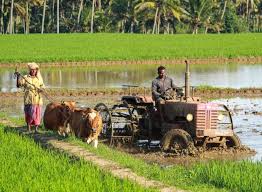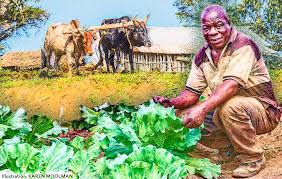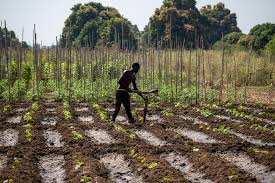Social change can bring about progress. Progress is change in a direction that is considered desirable. Progress leads to development, and development essentially is a continuous process of generating and efficiently allocating resources for achieving greater socially satisfying needs.
This article introduces various definitions of rural development, the basic process involved, and the strategies and approaches adopted in rural development.
Clarified Definitions of Rural Development from Agricultural and Social Perspectives
Within the structure of national development, the special attention being paid to rural development evolved from early thoughts on the role of agriculture in industrialization.
Prominent theoreticians in economic and broader social science literatures have paid attention to issues of agricultural and rural development and their interaction with industry and urban development (IDRC, 2004).
Until recently, “rural development” and “agricultural outputs” were considered synonymous. But agriculture is by no means the only possible occupation for people living in rural areas, and accordingly, a new and broader view has emerged which distinguishes rural from merely agricultural development.
Various scholars have defined rural development at different levels of what it involves. According to UNECA (1974), rural development is a process by which a set of technical, social, cultural, and institutional measures are implemented with and for the inhabitants of rural areas with the aim of improving their socio-economic conditions to achieve harmony and balance both on the regional and national levels.
This definition implies that many different elements must come together to achieve rural development. It means further integrating a set of sectoral programmes (health, agriculture, education, etc.) to achieve a comprehensive development of the rural area.
Similarly, but in more encompassing terms, Coombs and Ahmed (1974) defined rural development as the far-reaching transformation of the social and economic structures, institutions, relationships, and processes in any rural area.
It conceives the goals not simply as agricultural and economic growth in the narrow sense but also as balanced social and economic development, with emphasis on equitable distribution as well as the creation of benefits.
Among the goals are equitable access to arable land, more equitable distribution of income, widespread empowerment in health, nutrition, and housing, greatly broadened opportunities for all individuals to realize their full potentials through education and a strong voice for all rural people in shaping the decisions and actions that affect their lives.
A careful analysis of this definition implies the following:
1. Transformation in terms of changes in social and economic structures, institutions, relationships and progress are desirable.
2. Agricultural and economic growth are not sufficient; therefore, rural development should engender balanced social and economic development.
3. Benefits creation and distribution are desirable in equitable terms.
4. The outcome of the processes should include improved health, nutrition, and housing.
5. Education is a vital tool through which broadened opportunities could be generated for all individuals to realize their full potentials including women, youth, and the poor.
According to Williams (1978), the ambit of rural development is therefore very wide indeed. It includes generation of new employment; more equitable access to arable land; equitable distribution of income; widespread improvement in health, nutrition, and housing; maintenance of law and order; creation of incentives and opportunities for saving, credit, and investment.
It also involves creating wider opportunities for individuals to realize their full potential through education and sharing in the decisions and actions which affect their lives. It is not sectoral but comprehensive. In a nutshell, rural development is the result of many interacting forces.
Read Also: Gumboro Disease: Symptoms and Prevention
Basic Process Involved in Rural Development for Agricultural Progress

Rural development process evolves from a combination of a series of activities generated by creative human actions (element of innovation) backed up by available natural resources.
Rural development flourishes only under certain political, social, and economic conditions. Sometimes an individual or a small group of innovators triggers a process of rural development.
Sometimes it is promoted by changes in the economic or legal framework on the national or international level (European Rural Development, ERD 2005). All these point to one fundamental fact that rural development is characterized by great diversity of conditions, actors, and options.
Rural development is a cyclic process as presented in figure 2, which is characterized by four main activities as follows (ERD, 2005):
1. Analysis: what is the current situation?
2. Policy: who are the main actors and what do they want?
3. Modelling: which developments are possible?
4. Implementation: which measures should be used?
These four stages can be found in all kinds of development processes. They can also be found at different scales, from the initiative of an individual to the programmes of a national or international development agency. They are typically repeated many times to fine-adjust a development process.
It might be worthwhile to complement the above process by mentioning another process according to Jibowo (1992), which consists of five stages of a rural development programme as follows:
1. Enquiry: obtaining reliable and valid information about the target community (Availability of Rural Rapid Appraisal (RRA) and Participatory Rural Appraisal (PPR) tools have been found to be effective to achieve this in recent time).
2. Planning: based on information obtained from enquiry. It should involve interventionists (administrators), local change agents, representatives of the rural people and related agencies’ officials as stakeholders.
3. Implementation: action time for all concerned as stakeholders in systematic manner toward realizing the stated goals of the intervention.
4. Adjustment: necessary institutionalization and change resulting from the intervention.
5. Evaluation: adequate attention should be given to monitoring and review of the process to accommodate in-process modifications and at the end to determine how far the set goals have been realized and provide basis for further action.
Key Strategies and Practical Approaches Used in Agricultural Rural Development

A rural development strategy is a systematic, comprehensive, and reliable tool aimed at bringing about desirable rural transformation.
A strategy for rural development is expected to produce results; hence it is tested and found effective under certain circumstances before being introduced under similar circumstances in another setting. Its expected effectiveness could be because it is developed on basis of experience which had worked.
The strategies which had been adopted for rural development by many developing countries, according to Williams (1978), are:
1. Community development
2. Agricultural extension
3. Integrated rural development
1. Community development
Community development aims at utilizing the rural people to develop themselves through self-initiative and motivation with minimum assistance from government. It aims at social development such as prevention and control of juvenile delinquency and community development through self-help projects, health and nutritional improvement projects, and similar projects.
It involves community members in planning and implementing programmes for their own development. It stimulates government and other development agencies to provide technical advice and materials in planning and implementing the projects.
The multipurpose community development agent who is trained in many aspects of community life such as health, agriculture, education, cooperatives is stationed at the local level where he works with local people. To succeed, the community development worker needs to make use of the services of specialized agencies of government in the rural areas.
This is because it is not easy for an agent to be skilled in the rural sector.
If coordination and integration of activities of development-related agencies working in the rural areas can be facilitated through the efforts of the community development agent, this strategy could be more popular in rural development.
The problems in using this approach are:
1. It is not easy for one person to be effectively trained in all sectors of rural development; hence the community development agent may turn out to be ineffective.
2. There is often no formal coordination between the agencies working at the local level; hence the community development agent has no power to enforce cooperation by other agencies.
3. There is often a dilemma concerning whether community development should focus on development of the various sectors of the rural community or focus on educating the rural people on how to develop themselves and seek assistance for developing themselves.
Education is the cornerstone of all forms of development; hence it is advisable that rural people are educated on how to develop themselves. Even when infrastructural facilities are provided, the rural people should still be educated on how to maintain these and even introduce others.
2. Agricultural Extension
Agricultural Extension aims at assisting the rural farmers to bring about agricultural development. It does this by facilitating the education of farmers to improve their skills, knowledge, and attitude as related to agricultural development.
It transmits the results of research on how to solve problems of agriculture to farmers and encourages the application of these as well as other improved technical knowledge in agriculture by farmers.
It utilizes demonstration farms, farm visits, audio-visual aids and other methods in teaching farmers. While agricultural extension concentrates on agricultural development and only encourages related development agencies to extend their services to the rural areas, community development endeavours to provide some of the services.
The training received by the village agents is therefore aimed at equipping them to perform their different roles.
A glaring deficiency of the agricultural extension strategy had been its ineffectiveness in promoting agricultural development. The main reasons for this had been:
1. inadequate number of extension agents who are to teach farmers improved farm practices;
2. inadequate credit facilities to purchase farm inputs;
3. inadequate use of local leaders to assist extension agents in teaching farmers;
4. inadequate planning of extension programmes; and
5. inadequate motivation of extension agents. If these and similar problems are largely solved, extension should become an instrument for effective agricultural development.
3. Integrated Rural Development Strategy
Integrated Rural Development Strategy combines the development of the various areas of the rural society including agricultural, educational, health, nutrition, rural electrification, rural water supply and cooperative simultaneously.
The strategy also aims at improved employment, access to production resources, access to social services and management of development resources.
The distinguishing feature of this strategy is that the various development sectors are considered together rather than in isolation so that their relationships can be seen.
The use of this strategy involves increased mobilization and motivation of rural people to participate actively in decision-making processes concerning their progress and in the development activities.
There should also be established institutional relationships which will facilitate the development of the sectors. Rural development councils should be set up at the national, state, local government, and village levels to educate people, clarify ambiguities and mobilize moral and financial support for rural development.
Read Also: Vaccination Program for Poultry Chickens
Practical Approaches to Rural Development Implementation

Approaches for rural development are the geographical and the subject-matter scopes of rural development. Three approaches can be identified, namely:
1. the sectoral approach
2. the holistic approach
3. the regional approach
In the sectoral approach, rural development efforts are geared towards developing the various sectors of the rural society. Efforts are made to identify the important sectors such as the agricultural, health, education and infrastructural sectors of the rural society.
Development efforts are then focused on one sector. It is this tradition that had tended to favour the development of the agricultural sector, which had been regarded as the most important sector of the rural society in developing countries because majority of the rural population of these countries are engaged in it.
Experience with this approach had resulted in some problems, namely:
1. The agricultural sector had not been substantially developed partly because of its relationship with the other sectors which had not been supportive.
2. The other sectors had been largely ignored in the development process.
3. There had been overwhelming criticism of this approach by professionals from the other non-agricultural sectors.
The holistic approach attempts to develop all the sectors in a given area at about the same time. The agricultural, health, education, and rural infrastructural sectors are developed simultaneously. The problems with this approach are:
1. inadequate financial resources to implement development programmes in all the sectors simultaneously;
2. inadequate number of specialized and technical manpower to implement the programme; and
3. inadequate coordination of the development activities in the various sectors.
In the regional approach to development, a society is zoned into development regions which are most suited for establishing certain development projects.
In Nigeria for example, while potato production might be developed in the derived Savannah parts of the country, cocoa, kola and oil-palm production are naturally encouraged in the rainforest areas of the country.
Infrastructural facilities are developed all over the country. The major criticism of this approach is that it ignores the fact that scientific rural development aims at bringing development facilities to the rural areas where they do not originally exist, apart from developing the potentials where they naturally existed.
Another problem is that some regions might be ignored while others are developed or favoured on the basis of political advantage.
Do you have any questions, suggestions, or contributions? If so, please feel free to use the comment box below to share your thoughts. We also encourage you to kindly share this information with others who might benefit from it. Since we can’t reach everyone at once, we truly appreciate your help in spreading the word. Thank you so much for your support and for sharing!

